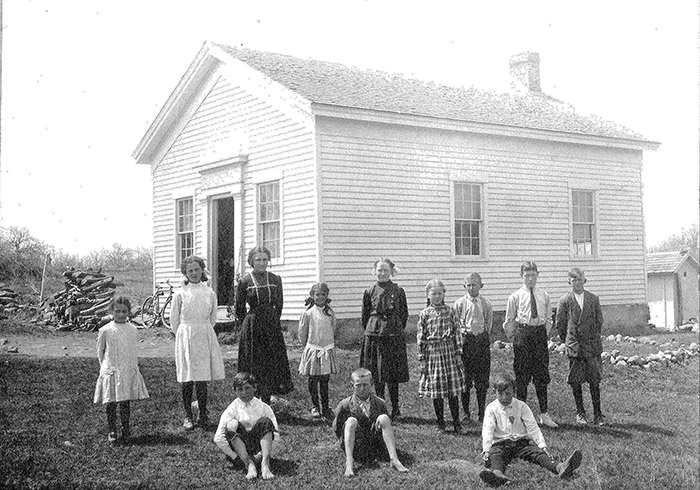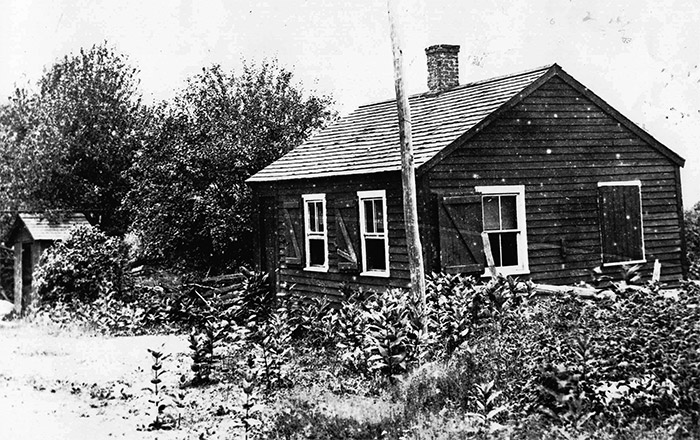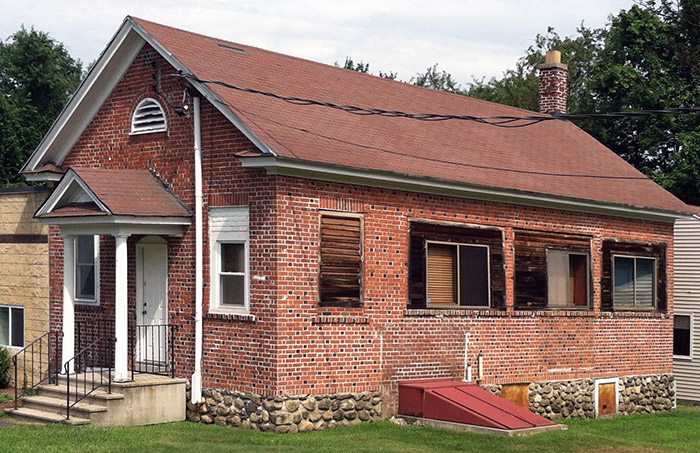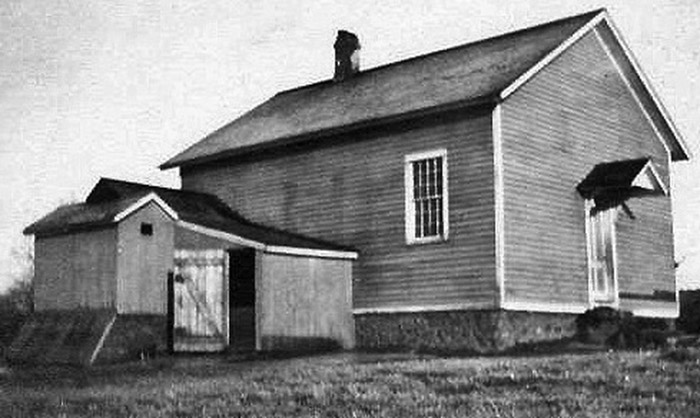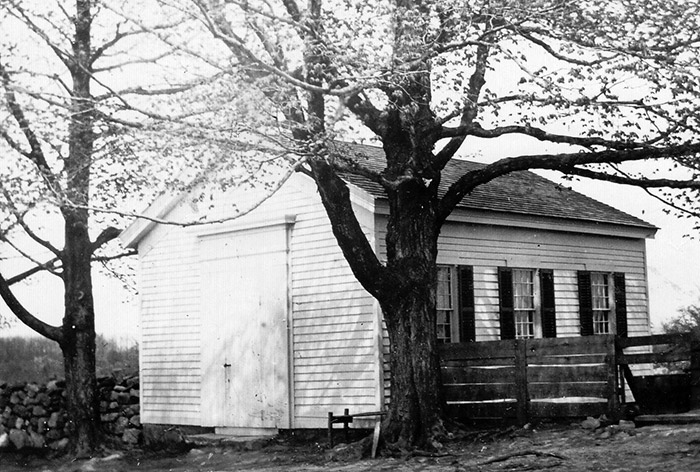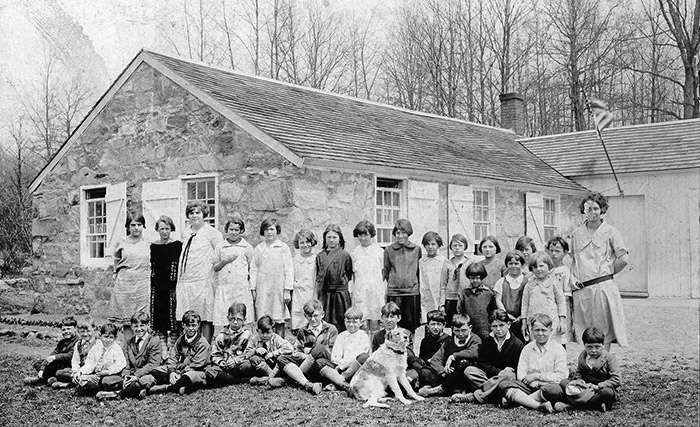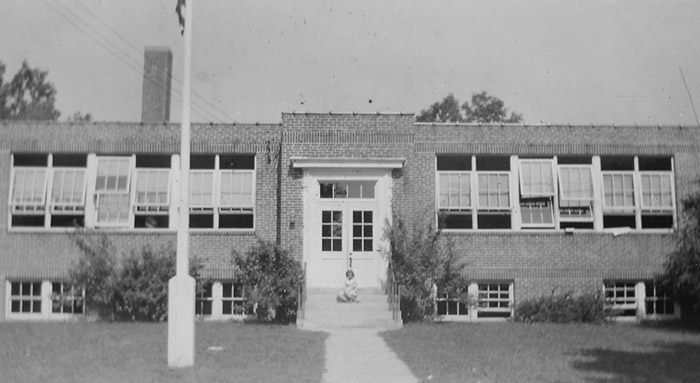|
|
||||||||||||
 |
 |
|
Wolcott Historical Society History for June 2014 By Florence Goodman This month I will share the last section of Clarence Atwood's handwritten memories about life in Wolcott in 1930. It will cover the five elementary schools that were in existence in Wolcott at that time; they were the Center School, West School, North School, Woodtick School and South School. Clarence attended the Center School on the Green and he always spoke of it with high regard.
"Center School was one room and served all eight grades. Teachers were hired for a one-year term and usually boarded with a nearby family. They rose early, breakfasted and walked to school. They tried to arrive in order to start the fire and prepare the day's work. In some instances, a teenaged boy helped start the fire-carried in a day's supply of firewood and fetched a pail of water from a nearby house. The pail stood on a shelf in the entryway with the communal dipper hanging nearby. Rows of pegs on the walls held clothes for outside wear. Lunchboxes, bags or Crisco cans held lunches. It was sometimes a surprise to the owner, to find someone had preceded him to lunch and a sandwich or apple was gone.
Classes were held in little groups, a grade at a time. It was a good system, as an alert student could overhear and even learn some of next grades work and of course review some of what he should have learned last year. Midmorning recess helped to wear off some youthful exuberance with games and noise. Lunch was one hour --- eat and get outside for games. Afternoon was a repeat of morning and school was out at 4:30 P.M. I can still remember the smell of the first day of school - newly varnished desks and a new box of crayons.
West School on Spindle Hill Road and North School on North Street were carbon copies. Woodtick School located on the site of the present Police Department was a newer building of two classrooms and had indoor plumbing. South School, later to be known as Lewis School was of two rooms also, located on Lewis Avenue.
Center School burned in 1929 and was replaced with a brick building, which presently serves as the superintendent's office. It had indoor plumbing and a furnace. At graduation exercises in June of 1935, the five grammar schools contributed a grand total of seventeen eighth graders."
When Clarence mentioned the Woodtick School, he was referring to the "new" Woodtick School, which was built in 1930 to replace the 1821 one room, stone structure that is now the home of the Historical Society's Museum. The "new" 1930 Woodtick School was demolished when the police station was built
One last recollection that I think you'd enjoy is by a teacher who taught in the old stone Woodtick schoolhouse in 1914. This story is dear to me because Irene Sullivan Coughlan was still teaching at Alcott School in the early 1950s when I was a student there. At that time Alcott School only consisted of eight classrooms, a principal's office, nurse's office, lunchroom and a boiler room. Here's what she had to say:
"My first teaching position was in the Old Stone School in Wolcott in 1914. I accepted the position in October, being the third teacher that Fall, to be greeted by a class of thirty-five children (eight grades) in that little one-room school. In the entry was a bench with a large pail for drinking water and a dipper. Of course, outside plumbing was in vogue at that time. The supplies and books were limited, but the children were a happy and an anxious group. Among my students were children from the Tyrrell, Wakelee, Browne, Bock, Williams, Mott, Reiser, and Brown families. My duties were custodian as well as teacher. The biggest problem was keeping the potbelly stove well fed. I walked from my house on Laurel Street in the East End of Waterbury to school. When I reached the George Browne residence on Wolcott Road, I stopped for a cup of coffee, collected the Browne children and continued on like the "Pied Piper" with other members of my class. After a few visits from the State Superintendent, Mr. Holmes, he agreed to get some one to help with the younger children. Miss Grace Munson (Mrs. Webber) helped me for a while. During the winter months, I boarded at the Cole home on Munson Road. It is a big roomy house. They were very kind people. Occasionally I would ride to Waterbury with Mr. Almus Browne, in his horse-drawn cutter. It was a treat to get home for a few hours. When spring came, I renewed my hikes from Waterbury, but rode home at five o'clock with Mr. "Tom" Horton, who was employed as a night watchman at Scovill Manufacturing Company. It was a challenging year, but a very rewarding one, because when I applied for my second position, I was highly recommended by Wolcott friends. My sincere thanks to Mrs. Charles Tyrrell, Mrs. Rose Wakelee Badger, and the late Mrs. George Browne for their wonderful help and cooperation. They succeeded in getting me a new dustpan, a broom and a few more essentials necessary for good housekeeping. Incidentally, my salary was $450 in ten payments."
This concludes the stories about life in Wolcott in the 1930s by Clarence Atwood. As previously stated, I am forever indebted to the Atwood family for sharing their father's stories and photographs with us. I hope this story adds to your understanding of life in rural Wolcott in 1930.
(Information for this article was taken from hand written stories of "Wolcott in 1930" by Clarence Atwood and pictures from the Atwood family's albums which were scanned by Mark McDonald and "My Teaching Experiences in Wolcott" by Irene Sullivan Coughlan)
Center School prior to 1929 fire.
Old North School was on North Street.
Second North School on North Street.
The West School on Spindle Hill Road.
The 1890s South School was located on the corner of Farview Avenue and Meriden Road.
Old Woodtick School in 1929. Loretta Leonard who is 98 is in this picture.
"New" Woodtick School was located on Nichols Road where the Police Station is today.
To view past installments of the Wolcott Historical Society News, click here.
|
|
|
[Home]
[News]
[Purpose]
[Calendar]
[Museum]
[Membership]
[History]
[Contacts]
[Links]
All material at Wolcott Historical Society Web sites Copyright © 2000-2014 Wolcott Historical Society |
